The Museum of Mediterranean and Near Eastern Antiquities was granted a generous donation from the A.G. Leventis Foundation in order to create a new Cypriote gallery, which was opened to the audience in Spring 2009.
The Cyprus Collections in the Medelhavsmuseet are the largest and most important collections in the world outside Cyprus. They are, however, not the most important in the world, which is stated on the poster and to the audience.
The old exhibition was closed 2004. These rooms now instead house the museum shop, with an extensive selection of goods from all over the world, mostly from Africa.
MODERN DESIGN
The sight of the immense wedge-shaped blocks rising up in the tiled inner courtyard immediately strikes the visitor. The much smaller showcases are built into these wooden constructions, painted green. According to the information, the exhibition is meant to help the audience to “feel the essence of Cyprus and experience the importance of religion in everyday life in ancient Cyprus.” The huge constructions are rather attractive, but give a heavy impression and contradict the very sense and meaning of the cults and culture of Cyprus – sunlight from a dark blue heaven, the slim building constructions of wood and white limestone, and the open-air sanctuaries where so many sculptures in the exhibition were found.
The exhibition proper is arranged chronologically, but also has a thematic division. The large headings below are the same as on the partitions in the exhibition, while the contents are written for this article. The headings are presented in the same order as in the exhibition.
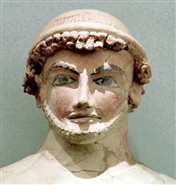 Terracotta statues from Mersinaki
Terracotta statues from Mersinaki
THE SANCTUARY AT MERSINAKI
At the entrance the visitor is met by imposing life size terracotta statues from Mersinaki, standing like guards along the wall with their right hand raised in a gesture of adoration towards the gods. The statues are all men with broad shoulders and a stiff stance. They wear the Greek chiton and himation and their curly hair and beards are arranged in a Greek fashion, but their frontal position and severe expression are Cypriote. The well-known gesture of adoration is analyzed, and the information compares the statues with Buddhist sculpture of the Gandhara type in India and Western China. The text also deals with the Babylonian pantheon, where one of the gods represents water, trying to show a supposed connection with Cyprus since the Mersinaki sanctuary is said to have been erected in a river delta.
 Apollo; an absent friend.
Apollo; an absent friend.
The information doesn’t tell us much about the sanctuary, huge in antiquity, where Apollo and Athena were worshipped at the same time.
CYPRUS THROUGH TIME
Cyprus, situated between Europe and Asia, has always been a meeting place and crossroad of civilizations. The island partook of every phase of its neighbour’s civilisation, which is illustrated by the nature of the island's material culture. The Cypriots however, never surrendered their own individuality or earlier achievements. Cyprus also influenced other cultures, as shown by the presence of Cypriot pottery all over the Mediterranean world. Indeed, Cyprus functioned as the intermediary of culture between Greece, the Ancient Near East and Egypt. Even the cult objects passed through Cyprus en route to other countries.
THE PEOPLING OF CYPRUS
Aetokremnos is a rock-shelter on the southern coast of Cyprus, on a steep cliff above the sea. It is the earliest archaeological site on the island where evidence was excavated suggesting that humans may have been responsible for the extinction of endemic pygmy hippopotamoi around 10,500 BC. The discovery of another important site at Parekklisha Shillourokambos has helped fill in the gap between the occupation at Aetokremnos in the 11th millennium and the canonical Aceramic Neolithic as represented at Khirokitia.
The Chalcolithic period (c. 3500 BC – 2500/2300 BC) was a very dynamic era and changes of major importance took place, including technological and artistic achievements. Metalwork appears for the first time, with a few chisels, hooks and jewellery of pure copper. Small cruciform figurines, many found in the area of Old Pathos, are unique to Cyprus and do not occur anywhere else. The soft green stone called pikrolite, allowed the artist to model the finest details and the strong stylization appeals to a modern eye. Maybe the woman was considered to be responsible for a fruitful harvest since her fertility was associated with the fertility of the soil. This idea existed in early agrarian societies where women probably performed the rituals. Recent research maintains the importance of women even in pre-Neolithic society, which is supposed to be equalitarian and without distinction of work.
The information consists of a few lines only, in spite of these interesting and eventful periods, when the future Cyprus took shape. It would also have been interesting to the visitor to learn about the fallow deer and its immense importance to Neolithic economy.
THE BIRTH OF APHRODITE: THE MYTH AND THE REALITY
The population of Cyprus has, since early Prehistory, been dependent on farming and the crops. From the earliest periods the principal deity was the great Mother Goddess and the worship of a fertility goddess always remained supreme in Cyprus. The Mother Goddess and her retinue of deities were worshipped to sustain life dependent on the soil. They protected the fields and the animals that enabled human beings to survive. Figurines comprising both male and female sexual attributes were perhaps perceived as extremely potent fertility symbols. The Neolithic statuettes might depict symbolic ancestors, perhaps an ancestral mother of a family cult or a matriarchal progenitor of a village clan. The cult of divinities, protecting the fertility of humans, animals and fields, was always important. The magic powers of the Goddess protected the home from evil powers.
Religion was influenced by the economic development, which in the Late Bronze Age was based on the trade with copper. The influence from the Near East grew on Cyprus after c. 1400 BC and brought new religious ideas, which influenced the design of the terracotta sculpture. A new type of female figurine with broad hips and a bird-shaped face is thought to originate from Syria, where she was an image of Ishtar or Astarte, the Oriental fertility goddess. The Oriental goddess was responsible for the fertility of men and animals. She was both mother and spouse, and was united with her son in a holy marriage, where the fertility of nature was guaranteed in a magic way. In Cyprus the youth Adonis was a god of vegetation, with power over nature. He was also the lover of the great Mother Goddess, who was later called Aphrodite. Every year they were united in a sacred marriage; a ritual act which was performed in the temple of the goddess. The king acted as the God of vegetation, while a priestess symbolised the Goddess.
This showcase is problematic since the visitor is not given any information about the rituals and cults of early Cyprus. Much stress is laid upon the Late Greek Aphrodite and her impact on modern Europe, but this has little to do with prehistoric Cyprus.
On the partition wall we see photos of paintings and sculpture from the Renaissance onwards, mixed with objects from Cyprus and Greece. The result is confusing, since the early fertility cults in Cyprus had little in common with the well-known representations of much a later Aphrodite and her Roman counterpart Venus. Information about early cults and their solid connection with the life and economy of the early Cypriotes, would have given more understanding of the complex religious life of ancient man.
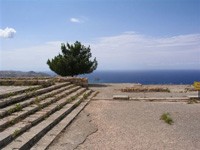
VOUNI
The most imposing building excavated by the Swedish Expedition was the royal palace at Vouni, situated on a hill at a height of 270 meters above sea level at the northwestern coast of Cyprus. The palace was waiting for them, with all its rooms, impressive staircases, storerooms and even a sauna. The inhabitants were all gone, but had left behind the silent sculptures, originally on position along the large staircases. A magnificent life-size head in limestone was found in the palace, today one of the highlights of Medelhavsmuseet. Close to the palace a small temple, dedicated to the goddess Athena, was built in the 5th century BC.

The showcase is very crowded and single objects of high quality are hidden among small finds and architectonical details from the palace. The famous so-called Vouni head is mounted on the wall at the far end. This masterpiece should have been mounted on a high pedestal, since the head originally belonged to a statue. In the case, there is a statuette of a young woman from Mersinaki that obviously found its way to the wrong showcase. A rhyton (ritual drinking-vessel) from Ayia Irini is exhibited close to a similar vessel from ancient Iran. It is probably intended to show the connections between Persia and Cyprus, but the proposed link to China is really surprising. There are information and photos about vessels in the shape of a ram's head from China. Some of the latest examples are dated to the Tang dynasty 618-907 AD.
It would have been interesting to read more about the supposed connection between Cyprus and the Far East, maintained in the exhibition.
BRONZE AGE CYPRUS
Cypriote Bronze Age, c. 2300-1000 BC
Farms and villages were now spread all over the island. New immigrants, probably from Anatolia, influenced both handicraft and technique. In religious ceremonies cult vessels were used. Several pots from the Early Cypriote period seem to have had a ritual function. Some have a round body, which perhaps symbolized the cosmos or the cycle of nature. People put offerings, like fruit and seeds, in small bowls on top of the ritual pots. The mining and production of copper from abundant ore deposits on the island was a source of prosperity and a complement to farming. Cyprus was famous for its rich copper mines in antiquity and the metal was smelted already during late 3rd millennium BC. Recent excavations show that the inhabitants of a village were able to organise an industrial production of copper already in the Middle Cypriote period. The trade in copper became an important factor in promoting social change by the end of the third millennium BC. Cyprus developed trade links and other social contacts with Syria, Anatolia, Egypt and the Aegean world during the course of the Bronze Age. About 1700 BC the smiths started to alloy copper with tin to make bronze. This metal was not available in Cyprus and had to be imported and the need for the metal stimulated long-distance trade even further.
During the Late Cypriote period, a flourishing trade with Syria-Palestine and Egypt brought enriching cultural influx from other countries. Life in the large towns became increasingly cosmopolitan. Mining became very important to the economy of the island, especially during the Late Cypriote period when metallurgy culminated during the 13th century BC. The export of copper brought more prosperity. Towards the end of the Bronze Age, c. 1100 BC, Mycenaean Greeks colonized Cyprus. A new monumental architecture was created in the shape of palaces and temples, built with large ashlar blocks. Cyprus experienced a real period of greatness. A flourishing trade with Syria-Palestine and Egypt also brought enriching cultural influx from other countries. Life in the large towns got an increasing cosmopolitan character.
The two cases are very crowded with all kinds of objects, giving a rather messy impression. Large pottery jars would have deserved more space and the smaller finds of other materials are difficult to discern. Not much information is to be found about the extensive Bronze Age of Cyprus and there is no connection between the lengthy text and the objects on exhibit. The small captions are placed high up and difficult to read, especially if you are in a wheelchair.
COPPER AND CULT
At the end of the Late Cypriot period, the Great Goddess also became the protector of metallurgy in Cyprus. The Goddess was still almighty, but she has a co-regent, a god who also was associated with the copper industry. During this period the copper industry was also developed and the task of the gods included the protection of the copper mines on the island.
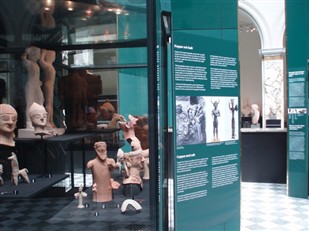
The Phoenicians colonized Cyprus around 900 BC and introduced their own deities. Statues of a male figure dressed in a tunic covered by a lion skin, brandishing a club and holding a lion, are reminiscent of both the Phoenician Melqart and the Greek Herakles. In 1929-1930, the Swedish Cyprus Expedition excavated a temenos, a sacred enclosure, situated on the acropolis of ancient Kition. A large amount of sculptures, almost exclusively male, dating from ca 560 to c. 450 BC, were found in deposit pits. However, the most impressive temple at Kition was dedicated to Astarte and it is the most monumental Phoenician temple ever found. It was excavated north of the Swedish site at the acropolis. From about 850 BC until the late 3rd century BC, the Astarte sanctuary in Kition was the centre of the religious life in the town and one of the most important sanctuaries on the island. The temples had been built close to the copper workshops. Metallurgy was possibly under the supervision under the priests and priestesses, and the production of the copper mines was dependant on the fertility gods.
The Cypriot Goddess was venerated in a twin-cult together with a male smithing god and was supposed to have a liaison with an Oriental war god. Perhaps the myth about Aphrodite, Hephaistos and Ares is of Cypriot origin. The Greek goddess Aphrodite also had a male counterpart, who was called Hephaistos by the Greeks. Her lover was Ares, the war god.
In this showcase there are exhibits from the Late Bronze Age until the Cypro-Classical period, mostly from Kition and Ayia Irini. The case is problematic since the finds from Ayia Irini have no link to metallurgy. The connection is, on the other hand, very strong between copper production and the great sanctuary of Astarte in Kition, but no mention is made of that goddess and her sanctuary. A picture of the Horned God from Enkomi is shown, beside a photo of the stone sculptures from Kition. This is also confusing since there is no link between the findspot of the Kition sculptures and the much earlier Horned God from Enkomi. The sculptures in the case were dedicated to Melquart, and found far away from the Astarte temple, and without connection with metalwork. The information and the sculpture in the case are very loosely linked together.
COPPER AND WAR
A small showcase reminds the visitor of the importance of the rich Cypriote copper mines, exploited from ancient to modern times. Large swords and small daggers of red arsenic copper or yellow bronze were found in a necropolis near Lapithos. The tools and weapons are chiefly made of arsenical copper, while there are very few tin bronzes. The weapons are exhibited together with a unique splint armour of iron and bronze from the 6th century BC. It was one of the votive gifts in a sanctuary, dedicated to the patron goddess of the town Idalion. The Phoenicians called her Anat, the Greeks called her Athena.
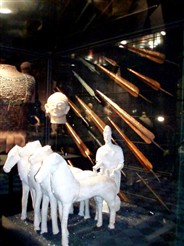
The shrine, dedicated to Phoenician Melqart at the acropolis of Kition, was not specifically martial. Melqart was rather the patron god of the town. It is far from sure that a war god resided in the Ayia Irini sanctuary, even if that could have been of one of his many functions. The splint armour is quite unique and deserves a case of its own. Further, the Phoenicians and the Greeks in Idalion venerated the same goddess, but they gave her different names. The Phoenicians called her Anat, the Greeks Athena. Thus, Athena was not the only goddess of Idalion.
THE ARCHAIC PERIOD
The sanctuary at Ayia Irini is characteristic of the agrarian cult, based on the worship of a divinity of fertility, found in various parts of the island. It was the most significant find of the Swedish Cyprus Expedition in 1929. Ayia Irini is one of the most notable rural sanctuaries of Cyprus and was to remain a sacred place for a thousand years. The most important period of the site was from c. 900-480 B.C., when it was an open-air sanctuary of the temenos type. The site constitutes a unique example of an Archaic temenos since the votive sculptures were found in undisturbed cultural strata, almost in their original position. 2000 terracottas were grouped around the cult stone, believed to have inherent powers of fertility.
The Minotaur, a crossbreed of bull and man, embodies an intermediate stage between the theriomorph and human shape of the votive figures at Ayia Irini. It represents the last phase towards a conception of the deity in human shape. The bull statuettes, the armed figures and the chariots indicate that a god of war, as well as a god of fertility and cattle, was venerated at the sanctuary.
The god worshipped at Ayia Irini was perhaps believed to reside in the cult stone, which had been used in the ritual already in Late Cypriot III, ca. 1200 B.C. The stone had been removed to the subsequent sanctuaries, which shows the continuity of the cult. This oval flood-stone or stone fetish was considered to possess magic powers. It was the tangible incarnation or the emblem of the god, and a symbol of his power. The cosmic egg, which also has an oval shape, has an important position in Greek so-called cosmogonies or myths and tales about the origin of the cosmos.
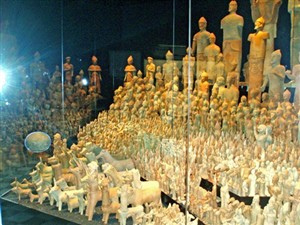
The information about this large showcase says that the “visitors step right into an antique cult setting re-created with thousands of terracotta statues from the island of the gods – Cyprus.” The huge rock-like construction, a seven meters tall monolith and weighing eight tons, is brooding hundreds of terracottas inside its belly. The Ayia Irini shrine was open to the sky and the rituals were performed in the open air. In the exhibition, the visitor is inside the large construction all the time, which rather gives the sensation of a cave instead of an open-air sanctuary. More problematic is the giant mirror inside the showcase, intended to give the visitor an impression of the complete terracotta group. Now it is difficult to discern which terracottas are for real and which are mirror images.
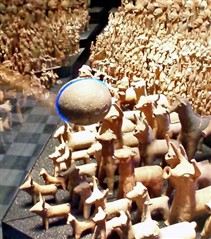
The sacred stone fetish was found beside an altar and the terracottas were grouped around it. Most of the sculptures were found at a distance from the stone to mark its sanctity. In this new arrangement, the stone is mounted in the mirror and has a plastic coil around it. The coil is constantly changing to different fluorescent colours. Immediately below the sacred stone, the terracotta bulls and figurines are staring upwards in consternation at this innovative use of a sacred object, transformed into a lighthouse.
Finally, the centaurs are Minotaurs, a crossbreed of bull and man and not of horse and man. Mention should have been made that some of them are much earlier than the major part of the terracottas.
THE CYPRIOTE KINGDOMS
Cypro-Geometric period to Cypro-Archaic period, c. 1050-480 BC.
Cyprus was successively divided into small independent kingdoms with a central city. Commerce flourished under sovereign monarchs. They built magnificent palaces and tombs of ashlars covered with mounds of earth. The commercial relations with the Near East were also increased. In art influences from Assyria, Syria and Egypt are visible. Many of the oriental motifs came from Syria via textiles.
Iron now became the common metal for weapon and tools.
Cyprus is perhaps less well known for its important role in the transition to iron during the 150 years after 1200 BC. Some of the most important developments in early iron technology took place on Cyprus, which is not mentioned in the exhibition. It seems that in the eastern Mediterranean area iron and steel suddenly came into use between 1200 BC and 1000 BC, mostly for making weapons, and that they gradually spread from there. Scholars maintain that by the beginning of the tenth century BC blacksmiths were able to steel iron. The earliest quenched-steel object is a knife (carburized iron knife) from Cyprus, dated about 1100 BC. New maritime trading routes opened to Crete in the Aegean and Sardinia in the central Mediterranean, in the quest for alternative metal supplies or for other resources in demand.
Life size statues
At the very back of the central hall, a number of life size limestone statues are exhibited, mostly hidden behind the huge “monolith”. There are Archaic statues from the Vouni palace and Karpassos, and the famous youth from Mersinaki, all of them real masterpieces. They deserve to have been exposed more visibly and with much space around them.
STUDY CORNER
In 2006, the Museum opened an introduction to the new Cypriote gallery, called The Expedition, which alludes to the Swedish Cyprus Expedition. Four immense showcases, literally crowded with pottery from all periods, are housed in a corner of the museum’s restaurant. The intention is to produce an atmosphere of the 1930’s. The corner is furnished with golden chairs and the showcases are made of brass; the whole room glimmers in the golden colour.
This is, however, far from the everyday life of the poor archaeologists, who seldom had money for necessary equipment or decent storerooms for the excavated objects. (During my many discussions with Einar Gjerstad before his death, he was joking about their constant lack of money. According to him, their standard diet was based on eggs..)
The noise from the restaurant is troublesome while the space is too small to concentrate on reading.
The A. G. Leventis Foundation also sponsors this corner.
IN SUM
The new Gallery of Cypriote Antiquities in Stockholm is partly very attractive and more finds than before are exhibited. The new location in the central hall gives the famous Cyprus Collection a place it deserves: as a focal point of the museum.
The information beside the showcases is quite insufficient and seldom relates to the exhibited objects. The text often presents ideas without any relevance to the objects on display, or even to Cyprus itself. The alleged connections between Cyprus and the Far East seems both odd and without foundation.
No catalogue has been produced, which to a great extent would have helped to introduce the visitor to the complex and fascinating history of Cyprus.
A good advice to an interested visitor is perhaps to go to the museum and judge it by himself, but to bring this article for information about the exhibits.
http://minervamagazine.com
Marie-Louise Winbladh
Archaeologist, author
1971-2001 curator of the Cyprus Collections in Stockholm
Kattgränd 10
S–11825 Stockholm
marie-louise.winbladh@comhem.se
http://cypernochkreta.dinstudio.se